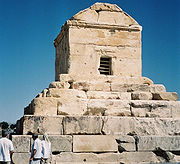Imperium Achaemenidarum
imperium antiquum
Imperium Achaemenidarum (lingua Persica antiqua 𐎧𐏁𐏂𐎶 Xšāça 'imperium'), etiam Imperium Persarum appellatum,[1] antiquate fuit magnum imperium in Asia Occidentali et Africa septentrionali constitutum et a Cyro Magno conditum. Quae civitas, tempore suae maximae magnitudinis, a Balcania et Europa Orientali in occidente in vallem Fluminis Indi in oriente extendit, ulli priori imperio historico maior, 5.5 milliones chiliometrorum quadratorum iungens.[2][3]


Religio
recensereQuamquam non erat religio publica, tamen in imperio gentes variae haud paucos deos venerebantur. Deus commodus quem reges venerebantur erat Ahura Mazda, opinabile omnium auctor et consuasor regibus spectatus, cuius signum erat ignis.
Imperatores
recensereLinguae imperii
recensereNexus interni
Notae
recensereBibliographia
recensere- Briant, Pierre. 2002. From Cyrus to Alexander: A History of the Persian Empire. Pennsylvania State University Press. ISBN 978-1-57506-031-6.
- Brosius, Maria. 2006. The Persians. Routledge. ISBN 978-0-415-32089-4.
- Brosius, Maria. 2021. A History of Ancient Persia: The Achaemenid Empire. Wiley-Blackwell. ISBN 978-1-444-35092-0.
- Cook, John Manuel. 2006. The Persian Empire. Barnes & Noble. ISBN 978-1-56619-115-9.
- Dandamaev, M. A. 1989. A Political History of the Achaemenid Empire. Brill. ISBN 978-90-04-09172-6.
- Heidorn, Lisa Ann. 1992. The Fortress of Dorginarti and Lower Nubia during the Seventh to Fifth Centuries B.C. PhD thesis, Universitas Sicaginensis.
- Kosmin, Paul J. 2014. The Land of the Elephant Kings: Space, Territory, and Ideology in Seleucid Empire. Harvard University Press. ISBN 978-0-674-72882-0.
- Kuhrt, Amélie. 1983. "The Cyrus Cylinder and Achaemenid Imperial Policy." Journal for the Study of the Old Testament 8 (25): 83–97.
- Kuhrt, Amélie. 2013. The Persian Empire: A Corpus of Sources from the Achaemenid Period. Routledge. ISBN 978-1-136-01694-3.
- Howe, Timothy, et Jeanne Reames. 2008. Macedonian Legacies: Studies in Ancient Macedonian History and Culture in Honor of Eugene N. Borza. Regina Books. ISBN 978-1-930053-56-4.
- Olmstead, Albert T. 1948. History of the Persian Empire. Sicagi: University of Chicago Press. ISBN 978-0-226-62777-9. Archivum.
- Taagepera, Rein. 1979. "Size and Duration of Empires: Growth-Decline Curves, 600 B.C. to 600 A.D." Social Science History 3 (3/4): 121. doi:10.2307/1170959. JSTOR 1170959.
- Tavernier, Jan. 2007. Iranica in the Achaeamenid Period (ca. 550–330 B.C.): Lexicon of Old Iranian Proper Names and Loanwords, Attested in Non-Iranian Texts. Peeters Publishers. ISBN 978-90-429-1833-7.
- Turchin, Peter, Jonathan M. Adams, et Thomas D. Hall. 2006. "East-West Orientation of Historical Empires." Journal of World-Systems Research 12, no. 2 (December): 223. ISSN 1076-156X.
- Wallinga, Herman. 1984. "The Ionian Revolt." Mnemosyne 37 (3/4): 401–437.
- Wiesehöfer, Josef. 2001. Ancient Persia. I. B. Tauris. ISBN 978-1-86064-675-1.